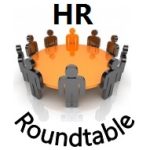When the May [Cincinnati] HR Roundtable got together, it jumped into the deep end (which is always fun)! Change is a reality, but we think it’s often overwhelming. It seems to swallow us. People tend to complain about change instead of work within in. So, the attendees considered these three questions to start the discussion:
- Why do people struggle with change?
- How can we go with the flow of change?
- How can you lead change?
As soon as the small groups started talking, they dove into the questions quickly. It was obvious that we had hit a sore point for many, so the discussions were very rich. Here’s what they had to share
1. Why do people struggle with change?
There’s a very strong emotional tie with change — Regardless of the type of change, emotions bubble up to the surface. Many times those feelings could be anxiety, fear or apprehension. When that happens, there is more trepidation about the anticipation of what “could” happen – even if it doesn’t. Emotions are part of the equation. You can’t take them out of it.
We feel a lack of control — We often feel that change happens “to” us. That may not be the case, but it is often what is expressed by people. People don’t like to feel uncomfortable. When there is the sense of things being out of one’s control, then change is difficult.
We tell others what to do and expect them to do it — Even though we want to think work environments have evolved, this is still the reality for most interactions. We have a negative “just do it” approach when we communicate work related items. These dictates rarely come with context because we feel that this would take too much time. It’s a huge barrier in the workplace.
We’re creatures of habit — This may be the biggest reality of all work. We park in the same places, take the same routes to work and have a certain step by step process as we face each day. We cherish stability and conformity because it makes us feel in control. This isn’t wrong. It’s very natural for us to want a life of vary little variety. So, when change hits we feel rocked more than we should. It’s because we don’t like our way of life/work to be disturbed.
2. How can we go with the flow of change?
Accept that change is happening whether you want it to or not — Change happens constantly. It just does. It’s much healthier for you when you come to terms with this. It’s the foundation of going with the flow. It needs to happen.
Assume the best will happen and view the opportunities — This runs contrary to how most people look at life. This takes effort, but it’s worth it. Going into change expecting that positive outcomes are possible takes courage. There’s no doubt about that, but I’d encourage you to try this approach.
Take risks and be vulnerable — This approach also runs contrary to how many look at work. The voices in your head try to dissuade you from taking even the smallest risk. Fight this and move forward because you’re taking steps to enter the flow of change. If you assess the risk before you move, that’s healthy. However, the assessment should lead to action instead of staying put. It’s time to move!
3. How can you lead change?
Stop being a martyr — We need to quit feeling that change is out to crush us. When you come across as a victim of change, people tend to put you in a box that you don’t want to enter. Having a healthy perspective about the reality of change is much more attractive than expressing the agony of it.
Give up control — Control is a myth. It really is. No one can account for all of the potential circumstances that can happen at any time and for any reason. We tell ourselves that we’re in control when we’re actually a moving part in an on-going continuum.
Be intentional and start to drive and direct change — Some people see this as risk taking, and it is. However, being intentional is a characteristic of a solid businessperson. More and more organizations want leaders who are intentional. It’s a great opportunity for you to grow within your role and within your organization as a whole.
Be a bridge that brings context — You can lead by making connections. Leading doesn’t mean that you have to do all of the work yourself. Great HR folks pull people together to enable change to occur. It’s a great business skill to exhibit and elevates HR in tangible ways. Be the one who gathers context and then shares it with others in order to bring clarity to change as it occurs.
Train others on how to address resistance — One of the attendees shared a great formula to keep in mind – Suffering = Pain x Resistance. This is flat solid! Since this is going to be a factor you face when it comes to change, provide training for others instead of succumbing to it. This is not an area that many companies currently address and is another opportunity for HR to shine.
Give others a vision regarding change — Leaders can cast a vision. People like to see what’s ahead as long as it’s tangible and attainable. Everyone wants to see forward. Step up. HR can do this and lead because vision involves people. Always remember that change involves humans. Therefore, HR has a rightful place in leading change. It’s just time for us to see it and start to consistently make that happen.
This was a very positive HR Roundtable – even more than usual. People felt more comfortable about the topic of change. It seems that we laid some groundwork to move forward, and that is spectacular!
